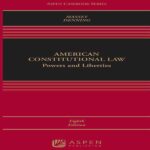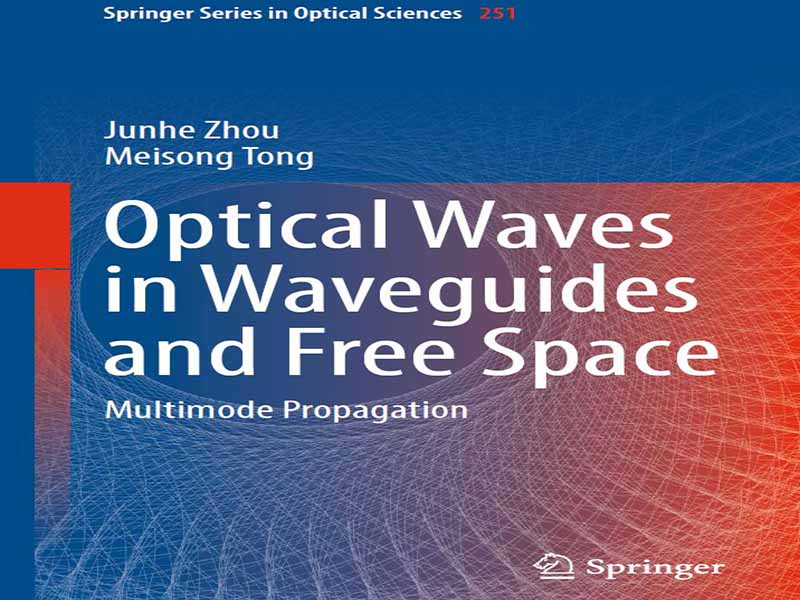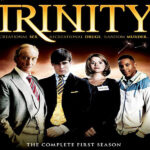- عنوان کتاب: Optical Waves in Waveguides and Free Space
- نویسنده: Junhe Zhou, Meisong Tong
- حوزه: امواج نوری
- سال انتشار: 2025
- تعداد صفحه: 365
- زبان اصلی: انگلیسی
- نوع فایل: pdf
- حجم فایل: 6.97 مگابایت
این کتاب مروری کامل بر انتشار چند مدی در داخل موجبرهای نوری و فضای آزاد ارائه میدهد. انتشار چند مدی در موجبرها و فضای آزاد اخیراً به دلیل کاربردهای امیدوارکنندهاش در زمینههای مختلف، مانند ارتباطات و حسگری، مورد توجه ویژه قرار گرفته است. در موجبرهای چند مدی و فضای آزاد، مدها به دلیل نوسانات ضریب شکست عمداً مهندسیشده یا تصادفی با یکدیگر جفت میشوند. مدهای جفتشده با یکدیگر تداخل میکنند و احتمالاً میتوانند برای تشکیل دستگاههای کاربردی مورد استفاده قرار گیرند. در این کتاب نشان داده شده است که میتوان از یک نظریه مد جفتشده جهانی برای توصیف انتشار مد در داخل موجبرها و در فضای آزاد استفاده کرد. میتوان بر اساس این نظریه، تحلیل تصادفی انجام داد و راهحلهای تحلیلی را برای گشتاورهای مرتبه دوم و مرتبه چهارم استخراج کرد تا از شبیهسازیهای مونت کارلو که زمانبر هستند، جلوگیری شود. پس از آن، دستگاههای تولید مد و مالتیپلکسینگ مورد بررسی قرار میگیرند که نقشهای کلیدی در سیستمهای مالتیپلکسینگ تقسیم مد ایفا میکنند. در نهایت، این مفهوم برای حوزه زمانی و فضای چهاربعدی زمان گسترش مییابد. این کتاب مروری جامع بر حوزه به سرعت در حال گسترش سیستم انتقال چند حالته و فیزیک پایه آن ارائه میدهد، طیف وسیعی از مباحث و کاربردهای ویژه مربوط به فناوریهای اصلی سیستمهای مالتی پلکس تقسیم حالت را پوشش میدهد و کاربرد گسترده سیستمهای انتشار و انتقال چند حالته را نشان میدهد. این کتاب به شرح زیر سازماندهی شده است. فصل 1 “مبانی انتشار چند حالته”. این فصل فیزیک بنیادی انتشار چند حالته در داخل موجبرها و در فضای آزاد را بررسی میکند. نظریه حالت جفت شده استخراج میشود. نظریه تداخل چند حالته آشکار میشود. فصل 2 “تداخل چند حالته در موجبرها و فضای آزاد”. این فصل به مدهای موجود در موجبرها یا فضای آزاد میپردازد که با سرعتها و ثابتهای انتشار مختلف منتشر میشوند. تداخل مورد انتظار است و میتوان از آن برای طراحی دستگاههای کاربردی مفید مانند کوپلرهای تداخل چند حالته استفاده کرد. دستگاههای کاربردی مانند ترانسفورماتورهای واحد بر اساس مفهوم تداخل چند حالته طراحی میشوند. در فضای آزاد، تداخل چند حالته به عنوان اثر تالبوت توصیف میشود که میتواند برای تولید مدهای فضایی مورد استفاده قرار گیرد. فصل ۳ «نظریه مد جفتشده برای انتشار چند مد». این فصل نظریه مد جفتشده را معرفی میکند که ابزاری قدرتمند برای تحلیل انتشار چند مد است. نظریه مد جفتشده هم برای اپتیک کلاسیک و هم برای اپتیک کوانتومی فرموله خواهد شد. در حالی که نظریه مد جفتشده ابزاری قدرتمند برای تحلیل انتشار چند مد در اپتیک کلاسیک است، فرمولبندی کوانتومی انتشار چند مد پس از آن ارائه میشود. فصل ۴ «انتشار موج در فیبرهای چند هستهای». این فصل فیبرهای چند هستهای را بررسی میکند که به عنوان نوع خاصی از موجبر چند مدی در نظر گرفته میشوند، در حالی که هستهها به طور نزدیکی به یکدیگر جفت شدهاند و ابرمدها را تشکیل میدهند. این مفهوم مورد بحث قرار گرفته و راهحلهای تحلیلی برای فیبرهای چند هستهای مختلف با آرایش هستههای مختلف ارائه شده است. فصل ۵ «نظریه جفتسازی تصادفی برای موجبرهای چند مدی و انتشار فضای آزاد». این فصل نظریه مد جفتشده تصادفی را بررسی میکند که در آن ضرایب جفتسازی به طور تصادفی تغییر میکنند و باید از طریق رویکرد تصادفی مورد مطالعه قرار گیرند. معادلات اساسی ارائه شده و نتایج تحلیلی برای مقدار میانگین و همچنین گشتاورهای مرتبه دوم و چهارم نیز به صورت تحلیلی مورد مطالعه قرار گرفتهاند. فصل 6 “تولید و مالتیپلکس کردن مد برای موجبرهای چند مدی و فضای آزاد”. این فصل به بررسی مولد مد و مالتیپلکسکننده میپردازد که اجزای کلیدی سیستمهای مالتیپلکس تقسیم مد هستند. این فصل روشهای جدید برای تحقق مولدهای مد و مالتیپلکسکنندهها را مورد بحث قرار میدهد. فصل 7 “مدهای زمانی و مدهای مکانی-زمانی”. این فصل نظریه انتشار پرتو مکانی را به حوزه زمانی گسترش میدهد و مفهوم موجبرهای زمانی و تبدیل فوریه کسری زمانی پیشنهاد میشود. پس از آن، یک ابزار پردازش سیگنال زمانی، یعنی یک شبکه عصبی عمیق پراش زمانی، پیشنهاد میشود. این مفهوم فراتر از حوزه مکانی یا حوزه زمانی، بلکه به فضای چهاربعدی زمان گسترش مییابد. یک کلاس جدید از پرتو مکانی-زمانی مورد بحث قرار میگیرد و در پایان یک شبکه عصبی عمیق پراش مکانی-زمانی پیشنهاد میشود. در نهایت، نویسندگان مایلند از تلاشهای ویرایشی دانشیار جینگ ژنگ از موسسه فناوری شانگهای و همچنین مشارکت دانشجویان دکترا تنگیوان لیو و چن چن از دانشگاه تونگجی قدردانی کنند.
This book provides a thorough review of the multi-mode propagation inside the optical waveguides and free space. Multi-mode propagation in waveguides and free space has received particular attention recently due to its promising applications in various areas, such as communications and sensing. In the multi-mode waveguides and free space, the modes couple to each other due to the purposely engineered or random index fluctuations. The coupled modes interfere with one another and can be possibly exploited to form functional devices. It is revealed in this book that a universal coupled mode theory can be used to describe the mode propagation inside the waveguides and in free space. Stochastic analysis can be performed based on the theory and analytical solutions can be derived for the second-order and fourthorder moments to avoid time consuming Monte Carlo simulations. Mode generation and multiplexing devices are under consideration afterwards, which play key roles in mode division multiplexing systems. Finally, the concept is extended for the temporal domain and the four-dimensional space time. The book provides a comprehensive reviewof the rapidly expanding field of multimode transmission system and its basic physics, covers a vast array of special topics and applications related to the core technologies of the mode division multiplexing systems, and illustrates the wide use of the multi-mode propagation and transmission systems. The book is organized as follows. Chapter 1 “Multimode Propagation Fundamentals”. The chapter reviews the fundamental physics for multi-mode propagation inside waveguides and in free space. Coupled mode theory is derived. Multi-mode interference theory is revealed. Chapter 2 “Multimode Interference inWaveguides and Free Space”. The chapter deals with the modes in the waveguides or free space which propagates with different velocities and propagation constants. Interference is expected and can be used to design useful functional devices such as multi-mode interference couplers. Functional devices such as unitary transformers are designed based on the multi-mode interference concept. In free space, the multi-mode interference is described as the Talbot effect, which can be exploited to generate spatial modes. Chapter 3 “Coupled Mode Theory for Multi-mode Propagation”. The chapter introduces the coupled mode theory, which is a powerful tool for multi-mode propagation analysis. The coupled mode theory will be formulated both for the classic optics and quantum optics. While the coupled mode theory is a powerful tool for multimode propagation analysis in classic optics, quantum formulation of the multimode propagation is provided afterwards. Chapter 4“Wave Propagation in Multi-core Fibers”. The chapter studies themulticore fibers, which are considered as a special kind of multi-mode waveguide while the cores are closely coupled to each other and form the super-modes. The concept is discussed and analytical solutions are given for various multi-core fibers with different core arrangement. Chapter 5 “Random Coupling Theory for Multi-modeWaveguides and Free Space Propagation”. The chapter studies the random coupled mode theory, which has the coupling coefficients varies randomly and should be studied through the stochastic approach. The basic equations are given and the analytical results for the average value, as well as the second- and fourth-order moments are studied analytically as well. Chapter 6 “Mode Generation and Multiplexing for Multi-mode Waveguides and Free Space”. The chapter studies the mode generator and multiplexer, which are the key components for mode division multiplexing systems. The chapter discusses the novel ways to realize mode generators and multiplexers. Chapter 7 “Temporal Modes and Spatiotemporal Modes”. The chapter extends the theory of spatial beam propagation to the temporal domain, and the concept of temporal waveguides and temporal fractional Fourier transform are proposed. Afterwards, a temporal signal processing tool, i.e., a temporal diffractive deep neural network is proposed. The concept is extended beyond the spatial domain or the temporal domain, but the four-dimensional space time. A new class of spatialtemporal beam is discussed and a spatial-temporal diffractive deep neural network is proposed in the end. Finally, the authors would like to acknowledge the proofreading efforts of associate professor Jing Zheng from Shanghai Institute of Technology, as well as the contributions of the PhD students Tengyuan Liu and Chen Chen from Tongji University.
این کتاب را میتوانید از لینک زیر بصورت رایگان دانلود کنید:




































نظرات کاربران